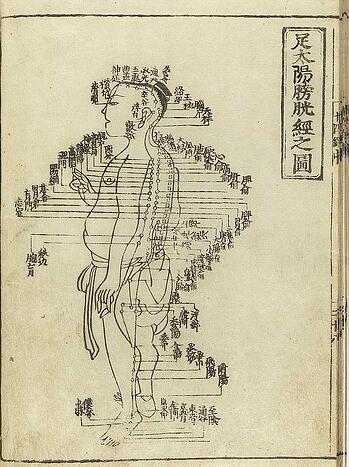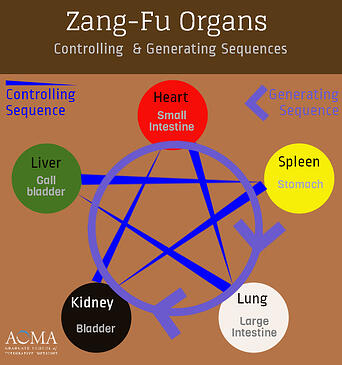You’ve probably heard someone describe the sensation of nervousness as having “butterflies in the stomach.” Perhaps you’ve referred to a person displaying restraint in the face of hardship as having a “stiff upper lip,” or a sensitive person as “wearing their heart on their sleeve.”
What about complimenting someone’s gallbladder when they accomplish something brave? Probably not, right?
This saying, often heard in China (and AOMA’s classrooms), has its foundations in the Traditional Chinese Medicine concept of the gallbladder as the source of courage and judgment. Attributing emotions, bodily manifestations, and physiological functions to organs is an important aspect of our medicine and an incredibly informative lens through which to view the body.
This practice is referred to as the Zang-fu system; it is a foundational tenant of Traditional Chinese Medicine (TCM). It builds upon Yin Yang theory as well as Five Element theory and is used as a launching pad for more complex TCM diagnosis. (If you need to brush up on Yin Yang theory and Five Element theory, read our Chinese Medicine School posts on the topics.)
The Zang-fu consist of eleven organs in total—five of which are considered Yin in nature and six of which are considered Yang in nature. The five Yin organs—Liver, Heart, Spleen, Lung, and Kidney—are referred to as the Zang. The Zang are solid organs and are responsible for the generation and storage of Qi, Blood, Body Fluid, and Essence.
Every organ has unique characteristics and functions. They are also said to “open into” certain body parts (thereby controlling that body part’s functioning) and manifest in others.
Liver
Element: Wood
Physiologic Functions:
- Stores Blood
- Controls the flow of Qi throughout the body
- Controls tendons and ligaments
- Houses the Ethereal Soul (“Hun”)
Opens Into: Eyes
Manifestation: Nails
Heart
Element: Fire
Physiologic Functions:
- Governs blood and controls the blood vessels
- Houses the mind (“Shen”)
- Controls sweating
Opens Into: Tongue
Manifestation: Facial complexion
Spleen
Element: Earth
Physiologic Functions:
- Governs transportation and absorption of food and water
- Controls the generation of ingredients for Blood
- Holds Blood inside the vessels
- Controls the muscles and the limbs
Opens Into: Mouth
Manifestation: Lips
Lung
Element: Metal
Physiologic Functions:
- Governs Qi and respiration
- Controls channels and blood vessels; Governs the exterior of the body
- Controls dispersing and descending of substances in the body
- Regulates water passage
- Houses the Corporeal Soul (“Po”)
Opens Into: Nose
Manifestation: Hair of the skin
Kidney
Element: Water
Physiologic Functions:
- Stores Essence
- Governs birth, growth, reproduction, and development
- Generates Marrow
- Controls Bones
- Controls water
- Control the reception of Qi (“root” the breath)
Opens Into: Ears
Manifestation: Hair of the head
Each Zang is paired with a Fu—one of the Yang organs. The Fu organs are hollow. They primarily receive and transport food and water throughout the body. These more active functions are the reason they’re considered to be more Yang than Yin. The organs and their pairings are listed below.
Zang: Liver
Fu: Gallbladder
Zang: Heart
Fu: Small Intestine
Zang: Spleen
Fu: Stomach
Zang: Lung
Fu: Large Intestine
Zang: Kidneys
Fu: Bladder
Zang: Pericardium (Though not always grouped with the five Zang organs, the Pericardium is considered the protector of the heart; it is also an acupuncture channel.)
Fu: San Jiao (also called the Triple Warmer and Triple Burner)
I t is important not to conflate the TCM organ with the Western anatomical organ. For instance, the Spleen in TCM isn’t necessarily the organ that filters the blood. Some features do overlap—for example, the Heart being involved with blood —but it’s best not to think of the Zang-fu as literal organs, but rather consider them figurative entities.
t is important not to conflate the TCM organ with the Western anatomical organ. For instance, the Spleen in TCM isn’t necessarily the organ that filters the blood. Some features do overlap—for example, the Heart being involved with blood —but it’s best not to think of the Zang-fu as literal organs, but rather consider them figurative entities.
Just as the Five Elements follow a generating and controlling sequence, the Zang-fu system can also be examined in this context. (For an overview of the Five Elements and to view the generating and controlling sequences, check out our blog post on the subject.)
These controlling and generating sequences are used to visualize the source(s) of pathological conditions and can be used to approach a treatment. For example, it is said in TCM that if an element (or organ) is in excess, an acupuncturist should “sedate the child.” So, if the Liver organ was hyperactive in a patient, the acupuncturist may choose to sedate the Heart.
The Zang-fu system is an incredibly important and consequential method of TCM diagnosis: It influences the diagnostic decisions, treatment plans, herbal prescriptions, and overall understanding of acupuncturists and herbalists the world over. The Zang-fu organs (including the Pericardium) also constitute the twelve primary acupuncture channels and are consequently used on a daily basis by most practicing acupuncturists. Take a moment to review the Zang-fu system and soon you will discover an entirely new way of viewing the human body.


